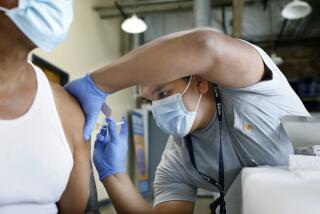Working Human Immune Systems Created in Mice
Two research groups working independently reported Wednesday that they have for the first time created a functioning human immune system in mice by implanting human tissues in a strain of mice that have no immune system.
This remarkable feat, the researchers said, should make it possible to study the effects of the AIDS virus on the human immune system without endangering people and thereby develop new clues about how to treat and possibly prevent this modern plague.
A new animal model may also make it easier to test new drugs and vaccines against AIDS because researchers might no longer have to use chimpanzees, which are both expensive and in danger of extinction, but which are also the only animal available for research known to be infected by an AIDS-like virus.
But the development may have ramifications stretching well beyond AIDS. One of the research groups created their immune system by implanting human fetal immune tissues in the mice, suggesting that the same techniques could be used to implant “virtually any other human tissue imaginable” and make it possible to create a whole new family of mouse models for human disease, said immunologist Irving L. Weissman of the Stanford University School of Medicine, who headed one of the groups.
“It’s a new way of doing human biology,” said Nobel laureate David Baltimore of the Massachusetts Institute of Technology.
The Stanford announcement coincided with a study by the Medical Biology Institute in La Jolla published today in the British journal Nature. The reports also came while a special committee of the National Institutes of Health was meeting in Washington to consider the ethics of using human fetal tissues in research. That committee is scheduled to draft its recommendations Friday.
Coincidentally, a confidential proposed executive order from the White House, leaked to the news media last week, indicated that President Reagan is attempting to ban all federally sponsored research using fetal tissues obtained from abortions. Clearly, many researchers hope that the successful attempt to reconstitute a human immune system in mice will galvanize support for future fetal research.
“Weissman’s results are a forceful argument that loss of this research material to investigators will deny gains in many different areas, including AIDS,” said immunologist David Scott of the University of Rochester Cancer Center. “Even if this weren’t useful for anything but AIDS, it would be absolutely, phenomenally important,” he said.
The two groups reporting their results Wednesday took strikingly different approaches to the problem of modeling a human immune system, and direct comparisons between their results are difficult. In fact, experts said, the two techniques may be more complementary than competitive.
Susceptible to Infection
But both used the same animals in their research: mice with an inherited disorder called severe combined immunodeficiency disease (SCID). These mice were first discovered in 1983 by biologist Mel Bosma of the Fox Chase Cancer Center in Philadelphia. They have a genetic abnormality that prevents their immune system from developing normally.
The SCID mice are highly vulnerable to infection and succumb to disease within three to four months after birth unless they are continuously treated with antibiotics.
In a series of experiments between 1983 and 1986, Bosma showed that immune tissues from the fetuses of healthy mice could be transplanted into the SCID mice, providing them with a functional immune system. But no one attempted the comparable experiment with human tissues, Weissman said, probably because they were discouraged by previous unsuccessful experiments using healthy mice.
In that early work, several researchers had destroyed the immune systems of mice with irradiation and then tried to implant human immune tissues, Weissman said in a telephone interview. In all cases, the experiments failed.
So when postdoctoral fellow J. Michael McCune suggested to Weissman that they try an experiment in the SCID mice two years ago, “I said, ‘I’ll bet it won’t work,’ ” Weissman recalled. “Fortunately, I was wrong.”
McCune removed liver, thymus and lymph node tissues from fetuses obtained from cooperating abortion clinics and either surgically implanted them next to the kidney of the SCID mice or simply injected them into the bloodstream.
Graft-Versus-Host Disease
The Stanford team used fetal cells because they feared that immune cells from an adult would attack the mouse tissues in a phenomenon known as graft-versus-host disease, which would kill the mice. Because the fetal cells would mature in the presence of the mouse tissues, they were less likely to mount such an attack.
The fetal liver cells were used because they contain the so-called hematopoietic stem cells, which give rise to all the body’s blood and immune cells. The thymus was implanted because it processes some of the stem cells so that they develop the ability to recognize and attack foreign tissues and organisms. The lymph nodes process other stem cells so that they produce disease-fighting proteins called antibodies.
In a paper scheduled for publication in the journal Science next week, Weissman, McCune and their colleagues report that this technique had apparently created a functioning immune system in more than 200 SCID mice. The most crucial evidence of success, according to a commentary in Science written by biochemists George D. Yancopoulos and Frederick W. Alt of Columbia University, is that the treated mice survived at least 15 months without developing any of the opportunistic infections that killed their brethren within four months.
The team is now trying to infect the mice with the AIDS virus, and preliminary results suggest that they will be successful, Weissman said.
‘Easier’ Approach Used
In the other experiments, immunologist Donald E. Mosier and his colleagues at the Medical Biology Institute, a small private research foundation in La Jolla, adopted what they term a much “easier” approach. They isolated all the white cells from a sample of adult human blood and injected them into the abdominal cavity of the SCID mice.
One hundred mice treated in this fashion developed a functioning immune system. Most were sacrificed to study components of the immune system, but five have survived for eight months without contracting opportunistic infections, the group reported. When the mice were injected with tetanus toxin (against which the white cell donors had previously been immunized), they produced human antibodies against the toxin.
“These cells are functioning normally,” Mosier said in a press conference. He also predicted that it would be about a year before the group could determine how the reconstituted immune system will react to the AIDS virus.
Other researchers were astonished by Mosier’s results because most believe that adult white blood cells transplanted in this fashion would mount a graft-versus-host attack on the mice. “It will be very interesting to find out why they don’t,” Scott said.
If Mosier’s results are replicated, experts said, his technique will have the advantage of making it possible to reconstruct immune systems using white cells from specific individuals, such as those in the various stages of AIDS infection. Researchers could also use cells from individuals with autoimmune diseases such as arthritis in which a person’s immune system attacks his own body.
His technique will also have the advantage that use of fetal tissues, with all its ethical land mines, will not be required.
Linda Roach Monroe in San Diego contributed to this story.
MAKING A MOUSE IMMUNE SYSTEM REACT AS HUMAN Researchers at Stanford determined that they could make mice that are born lacking an immune system accept human fetal tissue that would develop in a way to reconstitute a human immune system.
1. Specifically, researchers injected fetal liver, thymus and lymph node cells into the ill, or so-called SCID mouse. Because it lacks an immune system, the mouse will not reject the human tissue
2. Some of these cells migrate to the thymus, where they are transformed into T cells. Other lymph cells produce antibodies normally produced by the human immune system.
3. The altered, or so-called SCID-hu mouse, will appear to any virus as human cells do. The altered immune system apparently cannot be transmitted to offspring.
The components necessary for any immune system:
In the liver of the fetus are found a family of cells called hematopoietic stem cells. All the blood-forming and immune cells of the body are derived from these cells. In humans after birth, these stem cells are found in the bone marrow.
The thymus. Some stem cells released into the bloodstream migrate to the thymus, where they are processed so that they can distinguish between the body’s tissues and foreign tissues. The cells that have been processed are called T cells and are the cells infected by the AIDS virus. These cells are responsible for rejection of transplanted organs.
The lymph nodes. The rest of the stem cells migrate to the lymph nodes, where they are converted into B cells, which produce disease-fighting proteins called antibodies.






